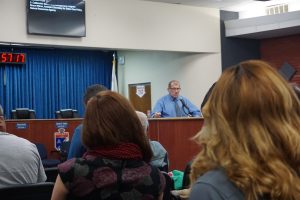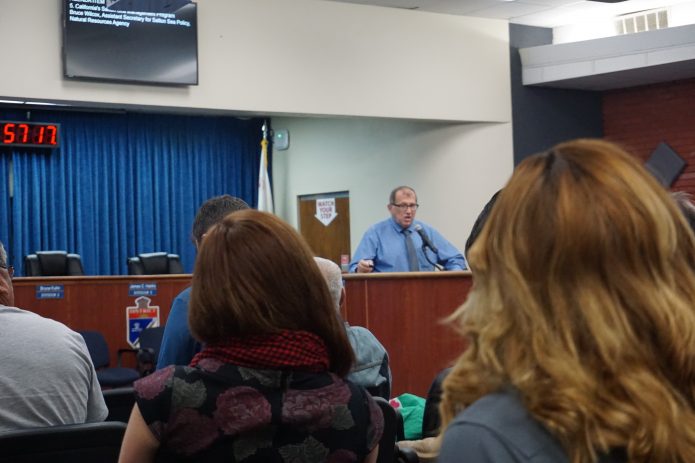
Bruce Wilcox, California Natural Resources Agency Assistant Secretary in charge of Salton Sea policy, talks to a standing-room-only crowd at the Imperial Irrigation District auditorium in El Centro on March 1 regarding the latest progress on the State’s Salton Sea Management Program.
A standing-room-only audience gathered Wednesday evening, March 1, at the Imperial Irrigation District auditorium to hear an update on the latest developments at the Salton Sea. The workshop was the first of two organized by IID, the San Diego County Water Authority, Imperial County and the California Natural Resources Agency. The second will be March 7, in Riverside County at the Coachella City Hall, from 5:00 p.m. to 6:30 p.m. Both workshops are meant to keep the public informed on the State’s restoration efforts at the Sea under the Stipulated Order, an amendment to the original water order approving the 2003 Quantification Settlement Agreement (QSA). The Stipulated Order, drafted by IID, the Water Authority and Imperial County, with support from Natural Resources and environmental organizations, requires the State to provide 30,000 acres of habitat and air quality projects at the Sea over the next ten years.
Speakers included IID General Manager Kevin Kelley, IID Water Manager Tina Shields, Imperial County Deputy County Executive Officer Andy Horne, Water Authority Assistant General Manager Dan Denham and Natural Resources Assistant Secretary Bruce Wilcox, who oversees Salton Sea policies. All discussed the importance of the Stipulated Order as a means of ensuring annual progress on the State’s Salton Sea Management Program (SSMP), a phased approach to restoration. The message was simple, yet critical. The SSMP, strengthened by the Stipulated Order, represents the best path forward to address the most immediate needs at the Sea while laying the groundwork for a long-term restoration.
The speakers pointed out that for the first time, the State has a feasible plan that represents the first steps toward meeting its restoration obligations under QSA-related Legislation. Additionally, there are funding sources to make the SSMP a reality. Proposition 68, a water bond that would provide $200 million for Salton Sea restoration, will go before voters in June. That bond, if approved by voters, would follow an earlier bond that provided $80 million for restoration. The financial pieces are starting to come together to ensure projects are implemented at the Sea with the most critical goal to protect public health.
The workshop also took into account that while the State is just beginning to launch its restoration program, a separate effort has been underway, since the QSA was signed, to implement an environmental mitigation program that addresses any impacts associated with the QSA. That mitigation program led by a Joint Powers Authority (JPA) made up of IID, the Water Authority, Coachella Valley Water District and the State, provided mitigation water to the Sea for the first 15 years of the QSA until December 2017. Now—as of 2018—the mitigation focus will shift into an air quality program that includes on-the-ground projects, which can work together with the State’s restoration program. Already, the JPA has funded over 1,000 acres of pilot projects at the Sea and, in 2018, will add 3,000 acres of new dust control projects.
Those who attended the workshop at the IID auditorium had a chance to ask questions after the presentations. For example, one area farmer asked whether there had been any thought given in developing a restoration program to the concept of reclaiming exposed playa at the Sea for farm ground. Currently, there is at least one pilot effort underway to determine if crops can be grown on the playa and the concept deserves further consideration.
The presenters made several key points, including that the longstanding environmental issues at the Sea will not be completely solved by the work done under the first ten years of the SSMP—more will have to be done and under the Stipulated Order, the State must have a long-term restoration plan in place in 2022. Another key message was that for the first time, there has been significant progress toward a restoration program with the focus now to move as quickly as possible on projects. Also crucial is acknowledgement of the Sea as part of the river system by the Basin States that depend on the Colorado River, like California, who are now endorsing the State’s SSMP. In the end, what you have is a unified front with expanding support for the Sea, which ultimately can bring positive results.
But, as has been said before and was said during the workshop—the restoration work has only just begun. We all must remain vigilant to ensure the State meets its milestones. In the meantime, the QSA JPA will continue to provide environmental mitigation at the Sea. If you have any questions regarding the separate JPA mitigation program, contact Darren Simon at dsimon@sdcwa.org.
